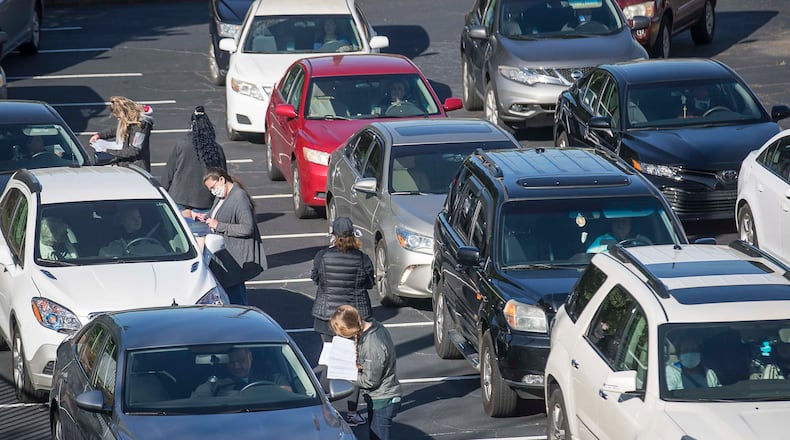The images are staggering: Cars stretched for blocks while drivers wait to pick up basic food supplies, with not all reaching the front of the line before the food is gone.
These drive-thru food giveaways have become another grim symbol of the coronavirus pandemic and a sign of how many families have found themselves unable to pay for food after large swaths of the economy shut down. Many food banks say they have been swamped with residents and families who are seeking the necessities.
That has put an extra burden on the Atlanta Community Food Bank, which has joined with local groups to host many of the recent food drives. CEO Kyle Waide told The Atlanta Journal-Constitution this week that the organization, which covers 29 counties in metro Atlanta and North Georgia, is facing an unprecedented situation during the pandemic, and leaders worry about how wide-reaching the problem of hunger could become in metro Atlanta.
What has the Atlanta Community Food Bank experienced since the crisis began?
“We’re seeing significant increase in demand, which should surprise no one,” Waide said.
Waide estimates there has been a 30 to 40% rise in the number of people getting food from food drives and other emergency sources. The food bank has distributed a total of more than 4 million meals in the past three weeks, a 30% increase in what it gave out before the pandemic began.
Credit: Steve Schaefer
Credit: Steve Schaefer
How exactly does the food bank work?
The Atlanta Community Food Bank is one of eight food banks that make up the Georgia Food Bank Association. Much of the food distribution efforts, however, happen through the food bank's 700 partners, a mix of local organizations like churches, food pantries and other nonprofits that get supplies from the food bank to distribute to their local communities.
When did the surge in demand begin?
The shift happened “virtually overnight,” Waide said. He recalled March 11, the day the NBA announced it was suspending its season and President Donald Trump banned most travel from Europe. The following day, metro Atlanta school districts announced plans to shift to online learning. After that, Waide said, “everything began to snowball.”
Credit: Alyssa Pointer
Credit: Alyssa Pointer
How does the food bank get its supplies, and what is it doing now?
The food bank typically gets a large chunk of its stock from local stores that donate excess perishable products. But the recent rush on grocery stores “really tightened the food supply chain in ways that we haven’t seen any time in recent history,” Waide said.
With grocery stores donating less, the food bank is now having to buy food by the truckload on the wholesale market, sometimes spending more than $1 million in one week, Waide said. For now, the food bank has been able to support those purchases though financial donations it receives.
What about volunteers?
The food bank typically uses 30,000 volunteers every year at its main facility, which just relocated to East Point. But due to social distancing concerns, it has stopped accepting volunteers at the main location, instead relying on staff members to help pack food. Georgia National Guard troops were also deployed to help out. Officials are recommending that prospective volunteers instead help with local food drives in their communities.
Credit: Jenni Girtman
Credit: Jenni Girtman
What is behind the surge in the need for food?
It is linked to the large number of layoffs and furloughs that followed the virus-related economic shutdown over the last several weeks, Waide said. More than half a million Georgians have filed claims for unemployment. The true number of people who are suddenly out of a job is certainly higher.
“Without question, there are a lot of people who are experiencing food insecurity for the first time,” Waide said.
What can the public do to help?
Direct online monetary donations are the best way to help the food bank, since most of their funding comes from individual contributions and large institutional donors. It also gets some public, government funds. You can also support one of the food bank's local partners in your community; a full list and map is available online.
About the Author
The Latest
Featured





